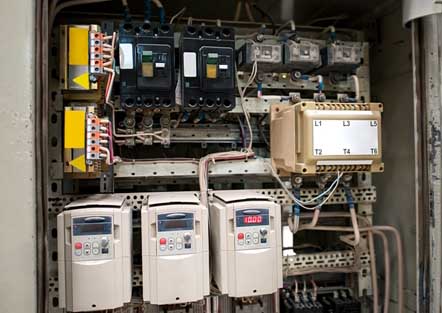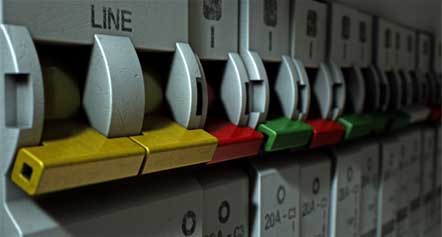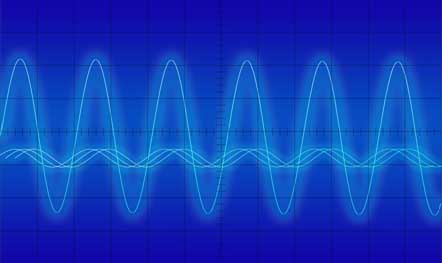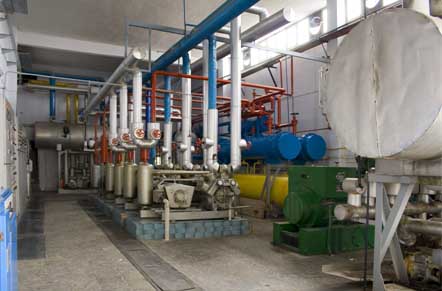Generator Protection

When generator control systems are designed, generator protection components are often included in the same cabinet for small to medium facility operations. The generator protection devices and wiring are separate from the control circuit devices and wiring. However, they can interface with the controls system for generator shutdown and alarms/monitoring capabilities.
Generator protection can be divided into the below categories:
- Internal Faults - Phase and/or ground faults in the stator and/or the field winding (rotor).
- Abnormal Operating Conditions - Issues such as: loss of field, overload, over voltage, under/over frequency, loss of synchronization, etc.
The generator is protected from internal faults within the rotor and stator by grounding methods. There are various methods used in grounding the generator. Grounding methods are proportional to size and complexity of facility (larger and more complex designs require more complex grounding circuit). If a generator does not have the appropriate grounding, the rotor and or stator can be damaged beyond repair during a ground fault event.
Protecting your generator from abnormal operating conditions is determined by the system. An emergency power system that only supplies power to lighting and emergency circuits would not need synchronization protection. This article provides information on field excitation, frequency, reverse power, circuit breaker pole flash over, and loss of synchronization failures.
Circuit Breaker Failures

Circuit breakers defend the generator rotor and stator against failure generated by a component(s) on the load side of the circuit. A line or supply circuit breaker supplies voltage to system breakers. Systems that require un-interruptible power can have redundant or backup capabilities to rapidly bypass the failed circuit breaker. This function can be automatic, manual or a combination of both depending on the failure.
Circuit breakers fail in two ways:
- Failed Open - Circuit breaker will not stay in closed condition after circuit repairs. Tripped breaker results in open circuit.
- Failed Closed - Contacts are welded together. The breaker conducts current flow in open, closed and tripped positions. This can cause a circuit to be inadvertently energized.
Breaker flash over also called arc flash is light and heat produced as part of the arc fault. Considered to be a type of electrical explosion. The discharge of the explosion results from a low-impedance connection through air to ground or another voltage phase. An arc blast is the supersonic shockwave produced when the uncontrolled arc vaporizes metal contacts. Flash over can occur during synchronization across breaker terminals while the breaker is open because of internal or external contamination, low dielectric pressure and humidity. Protection schemes are designed to accommodate the facility needs.
Excitation Failure

The generator consists of a rotor spinning in a magnetic field. Generators that use field coils require current flow to produce the magnetic field. The process of generating the magnetic field by use of an electric current is called excitation.
Loss of field can occur because:
- Tripping field breaker
- Open or short in field circuit. Can cause flash over of slip rings.
- Loss of supply to excitation circuit.
With generators operating in parallel, the generator with loss of field over speeds and operates as induction generator receiving excitation from system. Overheating of generator components are common problems. Loss of field protection circuits are designed to prevent unsafe and damaging operation of the generator when the field is lost.
When a generator receives more excitation voltage than required, the effect is counterbalanced by flux moving in the opposite direction added by AC supply and works on leading power factor as a capacitive load. If the excitation field is not correct, the generator will act as an inductive or capacitive load to the system. Advanced power systems will cycle generators that develop excitation failures off-line for troubleshooting.
Frequency and Power

The number of magnetic polls and the generator engine rpm are included in the calculation to figure the frequency of a generator. The equation is RPM x Poles /120. A generator with 4 poles running at 1800 RPM will generate 60 Hz.
If engine speed raises beyond governed setpoint or lowers because of mechanical or generator end issues the frequency will proportionally follow the engine. Increase in speed will command higher frequency and decrease will lower the frequency. Advanced systems can secure the affected generator and parallel a standby generator.
Generators exhibiting frequencies abnormalities must be repaired prior to assuming the load.
When generators are operating in parallel and one generator fails, it satisfies the criteria for a reverse power condition. The failed generator can act as a motor and draw current from the other generators operating on the grid. Power is lost from the grid from the lack of supply from the failed generator. In addition, the failed generator uses power from the grid to operate as a motor. More advanced systems have automatic transfer and paralleling systems that employ reverse power relays.
Synchronization is when more than one generator is used to supply power to the grid in parallel operation. When the generators are operating in parallel, the speed and frequency of the generators are matched proportional rising grid capability. A severe fault may cause loss of synchronism. This can take more than one generator out of service and cause partial or complete loss of power. Circuits have been developed to remove a generator out of service with zero voltage reading before loss of synchronization occurs.